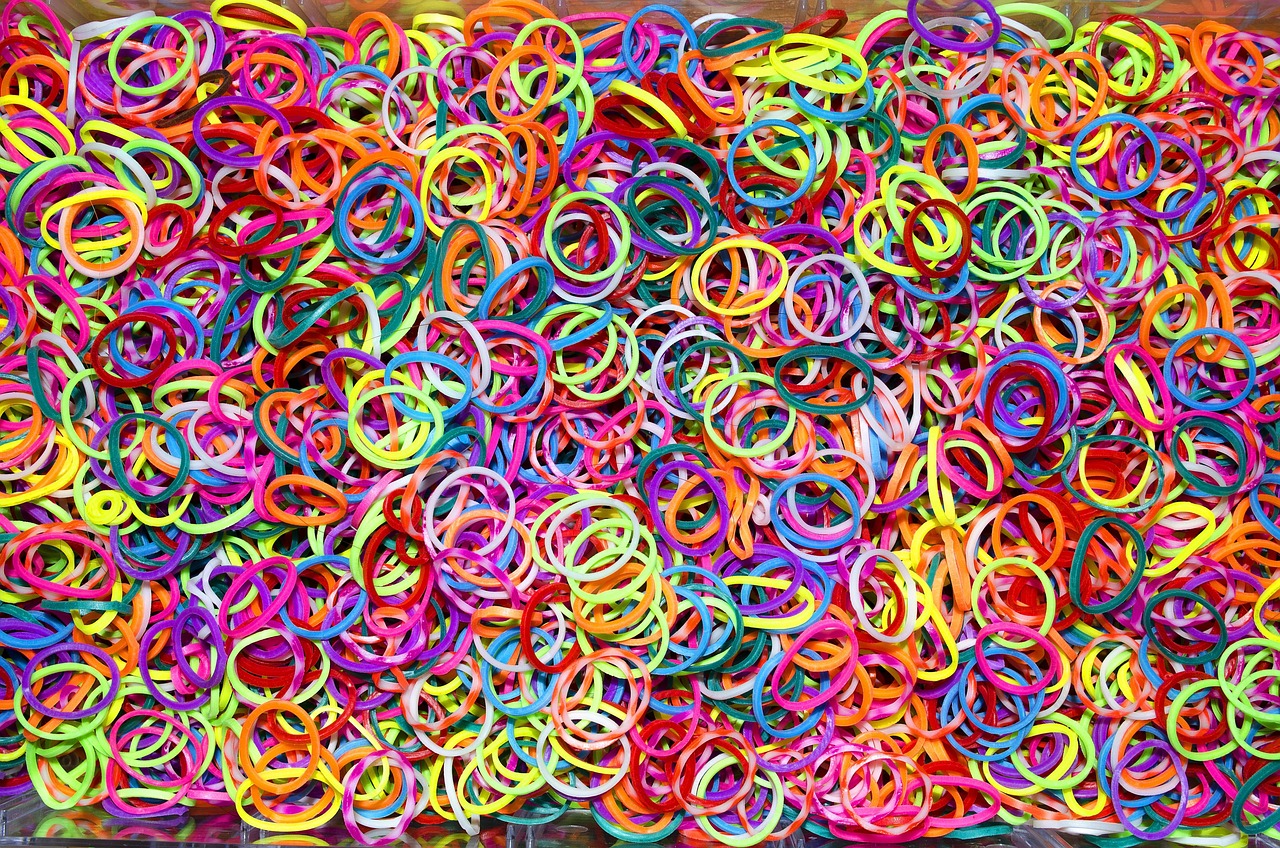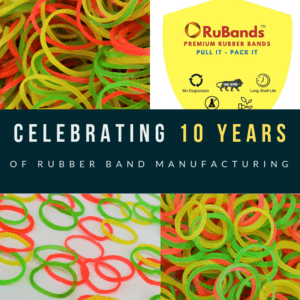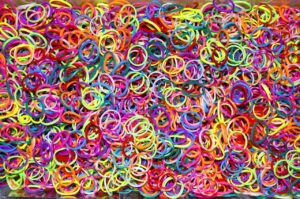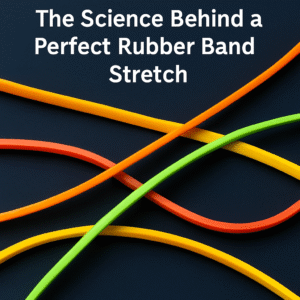How Fluorescent Rubber Bands Get Their Vibrant Color
There are regular colors, and then there is fluorescence. Walk through any stationery aisle or warehouse, and your eyes will inevitably be drawn to them: the electric greens, searing pinks, and blazing oranges of fluorescent rubber bands. They don’t just sit there; they seem to leap out, possessing a brightness that ordinary colors can’t match. This intense vibrancy isn’t a trick of the light or merely a strong dye. It’s the result of a fascinating scientific process where advanced color technology meets precision rubber band manufacturing.
So, what is the secret behind their super-bright appearance? How do manufacturers like RuBands infuse a simple rubber band with a color that seems to generate its own light? The answer lies in a special class of materials known as fluorescent pigments. These remarkable substances interact with light in a fundamentally different way than conventional pigments, creating the stunning visual effect we find so appealing. In this article, we’ll explore the science of fluorescence, dive into the manufacturing process, and reveal how these brilliantly colored bands are created from raw material to finished product.
Standard Color vs. Fluorescence: A World of Difference
To appreciate what makes fluorescent colors special, we first need to understand how we perceive standard colors. When white light (which contains the full spectrum of colors, from violet to red) hits an object, like a regular red rubber band, the pigment in the rubber absorbs most of the light spectrum but reflects the wavelengths our brain perceives as red. We see the color that is reflected back. The energy from the absorbed light is simply converted into a tiny amount of heat.
Fluorescence, however, is a two-step process that is far more dynamic and visually powerful. Fluorescent pigments have a unique molecular structure that allows them to perform an extraordinary feat of energy conversion:
- Absorption of High-Energy Light: Like standard pigments, they absorb light. However, their real talent is absorbing light from the higher-energy end of the spectrum. This includes not just visible violet and blue light, but more importantly, the invisible ultraviolet (UV) light that is abundant in daylight and also present in most artificial lighting.
- Emission of Lower-Energy Visible Light: This is where the magic happens. After absorbing a photon of high-energy light, an electron in the pigment molecule jumps to an excited, unstable state. It can’t hold this extra energy for long, so it almost instantly releases it. As it falls back to its normal state, it emits a new photon of light. Due to a small energy loss as heat during this transition, the emitted photon has a longer, lower-energy wavelength than the absorbed one. This phenomenon is known as the “Stokes Shift.”
Essentially, a fluorescent color is converting invisible UV light and visible blue light into extra visible light of its primary color (e.g., green, yellow, pink). This is why fluorescent rubber bands appear so much brighter than conventional ones—they are reflecting the visible light of their color *plus* emitting new visible light. It’s like having a tiny, built-in light source, making them pop under sunlight and seem to glow intensely under blacklights, which are pure UV sources.
The Star Ingredient: Understanding Fluorescent Pigments
The core of this advanced color technology is the pigment itself. These are not simple dyes but complex organic compounds encased in a polymer resin to form microscopic particles. Creating a high-quality fluorescent product is not as simple as just mixing these pigments into a batch of rubber. There are significant challenges that require deep expertise.
- Safety and Purity: First and foremost, the pigments must be non-toxic and stable, free from heavy metals or harmful chemicals. This is especially critical for bands that might be used in agriculture or for general consumer goods. RuBands sources only the highest-grade, certified-safe fluorescent pigments for all its products.
- Thermal Stability: The pigments need to be robust enough to withstand the rigors of the rubber band manufacturing process. The vulcanization stage involves high temperatures (often over 140°C or 280°F), which can destroy lesser pigments. Premium pigments are engineered to maintain their chemical structure and fluorescent properties even under this thermal stress.
- Lightfastness: A key challenge for fluorescent colors is their resistance to fading from prolonged exposure to UV light. The very process that makes them bright also makes them susceptible to eventual degradation. The quality of a fluorescent pigment is often measured by its lightfastness rating. RuBands selects pigments with high lightfastness to ensure our bands retain their vibrancy for longer.
Applications and Benefits: Why Go Fluorescent?
The vibrant nature of fluorescent colors is not just for aesthetics; it serves critical functional purposes across various industries, making these bands highly practical tools.
- Enhanced Organization and Sorting: In a busy warehouse, post office, or office environment, quick identification is key to efficiency. Using brightly colored fluorescent rubber bands for color-coding allows workers to sort mail, files, or product batches at a glance, reducing errors and saving time. A bundle secured with neon green can be instantly differentiated from one secured with hot pink.
- Increased Safety and Visibility: In industrial or agricultural settings, visibility is a safety issue. Tools, cables, or bundled items secured with fluorescent bands are much less likely to become tripping hazards or get lost. They stand out against natural or workshop backgrounds, ensuring they are easily seen.
- Agricultural and Produce Packaging: In the agricultural industry, fluorescent bands are widely used for bundling vegetables like asparagus, broccoli, and herbs. The vibrant colors stand out to workers during harvesting and processing, and they create an eye-catching display for consumers at the grocery store, suggesting freshness and quality.
- Promotional and Craft Use: The sheer visual appeal of fluorescent colors makes them perfect for promotional materials, craft projects, and any application where grabbing attention is the primary goal. They add a fun, energetic element that standard colors lack.
Conclusion: More Than Just a Pretty Color
The brilliant, eye-catching glow of fluorescent rubber bands is a masterful blend of physics, chemistry, and engineering. It is the successful result of combining advanced color technology with a meticulous and controlled rubber band manufacturing process. From the unique light-converting properties of fluorescent pigments to the expertise required to integrate them flawlessly into a durable, elastic rubber compound, every step is a testament to material science innovation.
At RuBands, we are proud to be at the forefront of this technology. We understand that our customers choose fluorescent bands not just for their looks, but for the tangible benefits they bring in efficiency, safety, and visibility. Our commitment is to deliver a product that is not only visually stunning but is also engineered to perform reliably in every application. They are proof that even the most common products can be sources of brilliant science.







